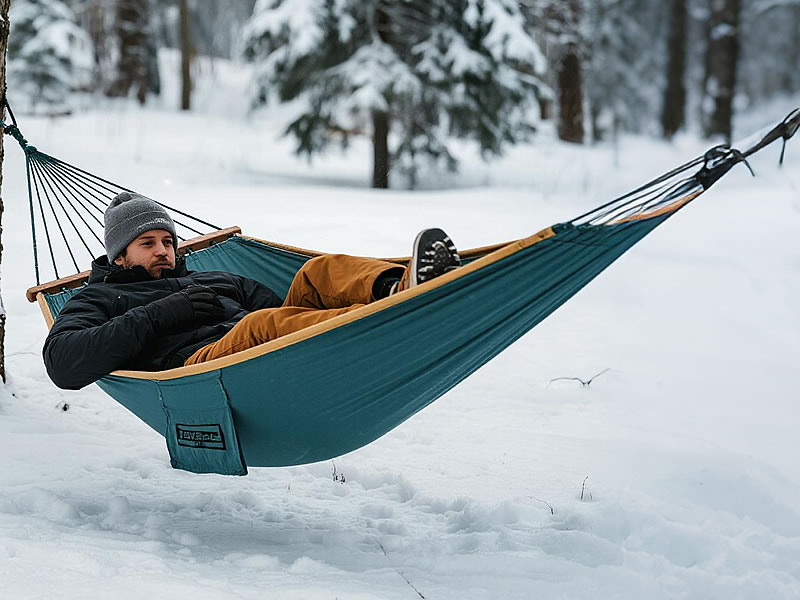Best winter camping hammocks for below-freezing temps
Winter hammock camping transforms snowy landscapes into dreamy bedrooms – but only if your gear can handle sub-zero brutality. Standard hammocks fail catastrophically in freezing temps due to inadequate insulation, wind penetration, and fabric stiffening. Here’s how to choose (and use) specialized winter hammocks that keep you warm, dry, and suspended safely in extreme cold.

Why Winter Hammocks Demand Unique Engineering
Conductive Heat Loss: Unlike tents, hammocks expose you to 360° cold air. Without bottom insulation, body heat drains rapidly into the atmosphere ("cold butt syndrome").
Material Failure Risk: Standard nylon becomes brittle below freezing, risking tears. Wind-driven snow abrades fabric, while moisture from breath freezes on bug nets.
Suspension Challenges: Frozen straps slip, knots tighten irreversibly, and metal hardware conducts cold to attachment points.
Critical Features for Sub-Zero Hammock Survival
- Windproof & Ice-Resistant Fabrics:Prioritize 70D+ ripstop nylon (like Onewind’s Tempest 12' Zipper Hammock) or polyester blends. These resist abrasion from ice crystals and block wind better than ultralight 20D fabrics2. Avoid cotton or untreated canvas – they trap moisture and freeze rigid.
- Full-Enclosure Designs:Top winter performers use zippered weather shells that seal like a bivy. Anymaka’s Hammock Tent exemplifies this with dual-layer doors and a waterproof canopy that locks out snowdrifts while retaining heat1. Integrated storm flaps over zippers prevent ice jams.
- Underquilt Compatibility:All recommended hammocks include attachment points for underquilts – the non-negotiable solution for bottom insulation. Look for dual-side channels or carabiner loops (e.g., Onewind’s system allows quilts to snap directly to the hammock body)2.
- Structural Ridgeline & Reinforcement:A fixed ridgeline (like Ticket to the Moon Lightest Pro’s) maintains optimal hammock sag despite fabric contraction in cold. Reinforced seams at weight-bearing points prevent blowouts when loaded with heavy winter gear2.
Top Winter Hammocks Tested in Extreme Cold
1. Anymaka Hammock Tent System: The All-Terrain Fortress
- Key Tech: Portable exo-frame stands independently (no trees needed), vital for alpine or tundra zones1.
- Winter Performance: CPAI-84 fire-retardant canopy withstands sparks from portable wood stoves. Full 20D nylon shell with battened doors blocks 35+ mph winds. Mesh roof covered by weather canopy traps heat while preventing condensation ice buildup1.
- Limitations: 31-lb total weight suits car/base camping only1.
- Pro Tip: Pair with a down underquilt for -20°F viability.
2. Onewind Tempest 12’ Zipper Hammock: The Budget Winter Warrior
- Key Tech: 70D hexagon ripstop nylon resists snow load and tree abrasion. 500-lb capacity handles thick sleeping bags + gear2.
- Winter Performance: Adjustable ridgeline fine-tunes sag for diagonal heat-conserving sleep. Zippered wind sock (sold separately) converts it into a semi-enclosed cocoon.
- Pair With: Onewind’s Penumbra Hot Tent Add-On ($189) adds stove-jack compatibility for sub-zero expeditions2.
3. Ticket to the Moon Lightest Pro: Ultralight Deep-Freeze Option
- Key Tech: 590g recycled nylon shell with DWR finish sheds snow. Integrated bug net doubles as a wind barrier when sealed.
- Winter Performance: Structural ridgeline ensures consistent lay for pad/underquilt synergy. Packs smaller than a Nalgene – ideal for ski/snowshoe approaches.
- Pro Hack: Add seam-sealer to zippers to prevent ice-induced jams.
Essential Winter Setup Hacks
- Tarp Strategy: Pitch a 4-season diamond tarp (e.g., Onewind Billow) low and angled into the wind. Use ski poles for snow-anchored guy lines2.
- Underquilt + Pad Combo: Layer a 0°F underquilt under the hammock with a closed-cell foam pad inside to eliminate cold spots.
- Moisture Murderers:Spray gear with permethrin to prevent ice-melt saturation from frozen condensation.Store water filters inside your sleeping bag to prevent cracking.
- Safety Musts:Test hangs at -10°F before expeditions – suspension shrinks!Carry a foam pad as emergency backup if underquilt fails.
Conclusion: Embrace the Frozen Hang
Winter hammocking isn’t about enduring cold – it’s about thriving in it. The Anymaka system dominates for tree-less expeditions, while Onewind offers modular affordability. Ultralight purists lean on Ticket to the Moon. All demand underquilts and storm tarps. Remember: your hammock is only as warm as its weakest insulation point. Master layered heat retention, respect fabric limits, and winter’s silence becomes your sanctuary.





